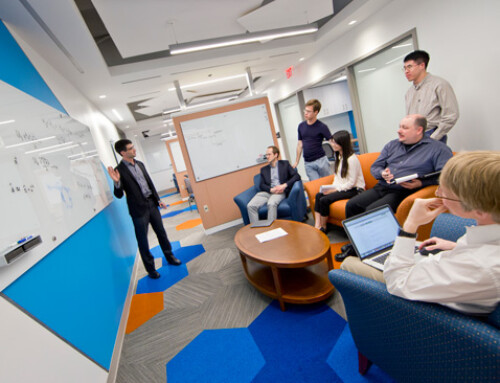The following post is a collaboration between visiting undergraduates Evan Giarta from Stanford University and Joy Hui from Harvard University. As mentors for the 2013 Caltech InnoWorks Academy, Evan and Joy agreed to share their experience with the audience of this blog.
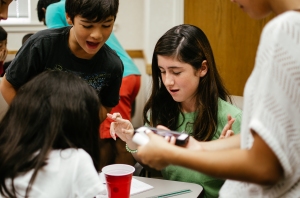 All throughout modern history, science and mathematics have been the foundation for engineering new, world-advancing technologies. From the wheel and sailboat to the automobile and jumbo jet, the fields of science, technology, engineering and math (STEM) have helped our world and its people move faster, farther, and forward. Now, more than ever, products that were unimaginable a century ago are used every day in households and businesses all over the earth, products made possible by generations of scientists, mathematicians, engineers and technologists.
All throughout modern history, science and mathematics have been the foundation for engineering new, world-advancing technologies. From the wheel and sailboat to the automobile and jumbo jet, the fields of science, technology, engineering and math (STEM) have helped our world and its people move faster, farther, and forward. Now, more than ever, products that were unimaginable a century ago are used every day in households and businesses all over the earth, products made possible by generations of scientists, mathematicians, engineers and technologists.
There is, however, some troublesome news regarding the state of our nation’s math and science education. For the past few years, education and news reports have ranked the United States behind other developed countries in science and mathematics. In fact, the proportion of students that score in the most advanced levels of math and science in the United States is significantly lower than that of several other nations. This reality brings to light a stark concern: If proficiency in science and math is necessary for the engineering of novel technologies and breakthrough discoveries, but is something the next generation will lack, what will become of the production industry, our economy, and global security? While the answer to this question might range from complete and utter chaos to little or no effect, it seems reasonable to try and avoid finding out. Rather, we–the community of collective scientists, technologists, engineers, mathematicians–should seek to solve this problem: What can we do to restore the integrity and substance of the educational system, especially in science and math?
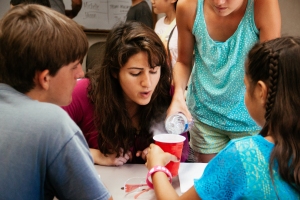 Although there is no easy answer to this question, there are ongoing efforts to address this important issue, one of which is the InnoWorks Academy. Founded in 2003 by a group of Duke undergraduates, the United InnoWorks Academy has developed summer programs that encourage underprivileged middle school students to explore the fields of science, technology, engineering, math, and medicine, (STEM^2) free of charge. The academy is sponsored by a variety of businesses and organizations, including GlaxoSmithKline, Cisco, Project Performance Corporation, Do Something, St. Andrew’s School, University of Pennsylvania, University of California, Los Angeles, and many others. InnoWorks Academy was a winner of the 2007 BRICK Awards and received both the MIT Global Community Choice Award and the MIT IDEAS Challenge Grand Prize in 2011. In ten short years, the United InnoWorks Academy has successfully conducted over 50 summer programs for more than 2,000 students through the contributions of over 1,000 volunteers. Currently, InnoWorks has chapters at about a dozen universities and is scheduled to add three more chapters this coming summer.
Although there is no easy answer to this question, there are ongoing efforts to address this important issue, one of which is the InnoWorks Academy. Founded in 2003 by a group of Duke undergraduates, the United InnoWorks Academy has developed summer programs that encourage underprivileged middle school students to explore the fields of science, technology, engineering, math, and medicine, (STEM^2) free of charge. The academy is sponsored by a variety of businesses and organizations, including GlaxoSmithKline, Cisco, Project Performance Corporation, Do Something, St. Andrew’s School, University of Pennsylvania, University of California, Los Angeles, and many others. InnoWorks Academy was a winner of the 2007 BRICK Awards and received both the MIT Global Community Choice Award and the MIT IDEAS Challenge Grand Prize in 2011. In ten short years, the United InnoWorks Academy has successfully conducted over 50 summer programs for more than 2,000 students through the contributions of over 1,000 volunteers. Currently, InnoWorks has chapters at about a dozen universities and is scheduled to add three more chapters this coming summer.
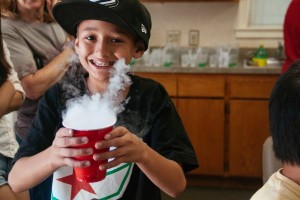 In early August of 2013, the Caltech InnoWorks chapter hosted its second annual summer camp, and Joy and I (Evan) were privileged to be invited as program mentors. As people on the inside, we got a first hand look at how the organization prepares and runs the week-long event and what the students themselves experience in the hands-on, interactive and collaborative one-of-a-kind opportunity that is InnoWorks.
In early August of 2013, the Caltech InnoWorks chapter hosted its second annual summer camp, and Joy and I (Evan) were privileged to be invited as program mentors. As people on the inside, we got a first hand look at how the organization prepares and runs the week-long event and what the students themselves experience in the hands-on, interactive and collaborative one-of-a-kind opportunity that is InnoWorks.
Since Joy and I kept a diary of each day’s activities, we thought you may like to see what our middle-schoolers experienced during that week. Here is a play-by-play of the first few days from Joy’s perspective.
Monday, August 5, 2013 was the first day of our camp! Before I go on with talking about the cool things we did that day, I’d like to introduce my team. The self-titled YOLOSWAG consisted of Michael, Chase, Evan, Phaelan and myself. Michael was the oldest, and a little shy at first, but he definitely started talking when he got comfortable. Chase was respectful and polite, and we hit it off immediately. Evan loved science and had lots of questions and knew a TON. Phaelan was the only other girl on the team, but she was very nice and friendly to the other students, and eager to help with anything she could. We all seem different, right? But wait, here’s the best part: we were all die-hard Percy Jackson (property of Rick Riordan) fans! We were definitely the best team.
Anyway, back to the actual stuff we did. One of the first things we saw was a cloud demo, essentially the creation of a cloud in a fish tank, with lots of dry ice and water. The demonstrator, Rob Usiskin, stuck a lot of dry ice in the (empty) fish tank, and poured some water into the tank, which caused the water to turn into a fog, which turns out to be the exact form of a cloud! Add a bubble maker, a question of whether bubbles will float or sink on the cloud, and a room full of InnoWorks campers (about 40 of them), and you will get an hour of general excitement. See the pictures for yourself! (The bubbles, float, by the way, even when the cloud is invisible!)
Following the demonstration, we made Soap Boats. We were apparently supposed to cut index cards into the shape of boats, and dab a little bit of soap on the bottom of the boat, and set the boat in the water. These “Soap Boats” were supposed to be propelled forward by the soap’s ability to decrease the surface tension of the water it touched. Ours, appropriately named “Titanic,” however, simply sat in the water until the water soaked through, and the Titanic sank for the second time in history. Many other teams’ boats fared about the same, but we certainly had a blast designing and naming our Soap Boat!
The last activity of the day was a secret message decoded with bio-luminescence. Each team was given a vial of dried up ostracods, which are sea creatures found glowing in the darkness of the deep sea. Then, each team crushed the ostracods and mixed the resulting powder with water to catalyze the bio-luminescence. Every mentor had written a secret message on a slip of paper, folded it, and handed it to their teams to decipher in the dark (Mine said: YOLOSWAG for the win). The convenient cleaning closet provided said darkness–Spiros, our faculty mentor, suggested that it might also provide passage to Narnia. I don’t think we lost any of our students that day, so no Narnia-traveling was done; by students. Nevertheless, it was a fun-filled and action-packed day, and a great start to an eventful week.
Tuesday was full of fun, hands-on activities. After a short lesson on the effects of air resistance and gravity on free-falling objects, we demonstrated the concept with a thin sheet of paper and a large textbook. As expected, when placed side by side and dropped, air resistance caused the sheet of paper to hit the ground much later than the textbook. But when the sheet of paper was placed directly above the textbook, to the shock of students, both items fell at the exact same rate. Though thorough in their knowledge of physical laws, the connection between their conceptual understanding and real life application had yet to be established. And as a result, when asked to explain what happened and why, the best answer one could muster was simply, “SCIENCE!”.
Following an exercise consisting of blow dryers and floating ping pong balls, the kids received a brief tutorial on how tornadoes are formed by air moving through high and low pressure regions and gusts of vertically rising winds. Due to the forces it is producing and acting upon, the tornado would then be able to more or less sustain itself. To explore this concept further, students constructed water tornado machines by taping two soda bottles together at their openings. Laughter and wetness ensued. Some groups added small trinkets in their tornado machine to observed the water tornado’s effect on “debris”. One team in particular inserted duct tape sharks, and aptly renamed themselves as Sharknado.
In the afternoon, the campers were presented a lesson on the transportation of sailboats and aircraft. Contrary to what most people intuit, the fastest way to control a boat is not to flow in the direction of the wind, but to place the sail at the heading which produces a net force, which can be explained by Bernoulli’s Principle. It states that faster moving fluid has less pressure than slower moving fluid, therefore producing a force from the slower moving side to the faster moving side. Though in sailing this force is initially barely noticeable, over time it creates a large impulse to move the craft at considerable speeds. The same principle can also explain the way a plane takes flight.
With the importance of good design in mind, students were tasked with prototyping the fastest water-bottle boat. Given a solar panel, electric motor, various propellers, empty bottle, tape, and other construction essentials, kids started with basic designs, then diversified in order to gain an edge against other teams. Some teams boasted two-bottle designs, and others used one, each type having trade-offs in speed and stability. Few implemented style upgrades with graphics and colors, and even fewer leveraged performance modifications with ballast and crude control systems. But with a tough deadline to meet, not all boats met their intended specifications. Nonetheless, the races commenced and each team’s innovation was tested in the torrents of Caltech’s Beckman Fountain. Some failed, but those that survived were rewarded accordingly.
By the end of the second day, many of the campers’ initial shyness had been replaced with conversation and budding new friendships. Lunch hour and break times allowed time for kids and mentors alike to hang out and enjoy themselves in California’s summer sun in-between discovering the applications of science and math to engineering, medicine, and technology. These moments of discovery, no matter how rare, are the reasons why we do what we do as we continue our research, studies, and work to improve the world we live in.[/fusion_builder_column][/fusion_builder_row][/fusion_builder_container]
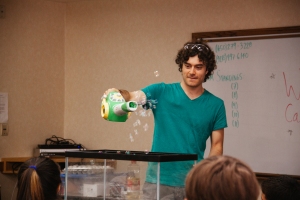
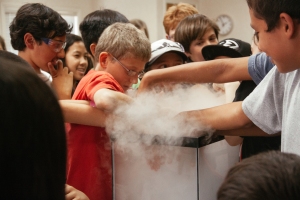
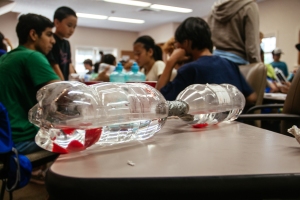
![Innoworks-82[1]](http://quantumfrontiers.files.wordpress.com/2013/09/innoworks-821.jpg?w=300)


